Design and Construction and Energy Consumption Study of a New Electrolyzed Water Cell Generator Prototype for Food Disinfection
Abstract
1. Introduction
2. Materials and Methods
2.1. Prototype for Producing Electrolyzed Water (EW)
- Control panel to manage production parameters including the pH (Figure 2a);
- Connection to the public water supply (Figure 2b);
- Self-cleaning resin filter to remove impurities from the water (Figure 2c);
- Pressure gauge to manage pressure and, consequently, flow rate (Figure 2c);
- A 100 L tank for NaCl saturated solution (Figure 2c);
- Tank for the electrolyzed water with a level sensor (Figure 2d);
- Electrolytic cell with platinum electrodes (Figure 2e);
- A peristaltic pump for feeding tap water (Figure 2e);
- A peristaltic pump for feeding saturated NaCl solution (Figure 2e);
- A peristaltic pump for pH correction (Figure 2e);
- Outlet pipes for anolyte (EW), catholyte and wash water (Figure 2f).
2.2. Setup of Eletrolysed Water Parameters
2.3. Antifungal Assays
2.4. Mass Balance Evaluation
3. Results and Discussion
3.1. Setup of Electrolyzed Water Parameters
3.2. Data from Antifungal Assays
3.3. Mass Balance Evaluation
4. Conclusions
Author Contributions
Funding
Institutional Review Board Statement
Informed Consent Statement
Data Availability Statement
Acknowledgments
Conflicts of Interest
References
- Rahman, S.M.E.; Khan, I.; Oh, D.H. Electrolyzed water as a novel sanitizer in the food industry: Current trends and future perspectives. Compr. Rev. Food Sci. Food Saf. 2016, 15, 471–490. [Google Scholar] [CrossRef]
- Saxena, J.; Williams, T. Electrolysed water (hypochlorous acid) generation and efficacy against food-borne pathogens. Sustain. Food Technol. 2023, 1, 603–609. [Google Scholar] [CrossRef]
- Manzocco, L.; Ignat, A.; Anese, M.; Bot, F.; Calligaris, S.; Valoppi, F.; Nicoli, M.C. Efficient management of the water resource in the fresh-cut industry: Current status and perspectives. Trends Food Sci. Technol. 2015, 46, 286–294. [Google Scholar] [CrossRef]
- Gombas, D.; Luo, Y.; Brennan, J.; Shergill, G.; Petran, R.; Walsh, R.; Hau, H.; Khurana, K.; Zomorodi, B.; Rosen, J.; et al. Guidelines to validate control of cross-contamination during washing of fresh-cut leafy vegetables. J. Food Protect. 2017, 80, 312–330. [Google Scholar] [CrossRef]
- López-Gálvez, F.; Tudela, J.A.; Gil, M.I.; Allende, A. Use of chlorine dioxide to treat recirculated process water in a commercial tomato packinghouse: Microbiological and chemical risks. Front. Sustain. Food Syst. 2020, 4, 42. [Google Scholar] [CrossRef]
- Bolin, H.R.; Stafford, A.E.; King, A.D., Jr.; Huxsoll, C.C. Factors affecting the storage stability of shredded lettuce. J. Food Sci. 1977, 42, 1319–1321. [Google Scholar] [CrossRef]
- Zhang, S.; Farber, J.M. The effects of various disinfectants against Listeria monocytogenes on fresh-cut vegetables. Food Microbiol. 1996, 13, 311–321. [Google Scholar] [CrossRef]
- Krahn, T.R. Improving the keeping quality of cut head lettuce. Acta Hortic. 1977, 62, 79–92. [Google Scholar] [CrossRef]
- Nagashima, T.; Kamoi, I. Sterilization and preservation of vegetables by ozonated water treatment. Food Preserv. Sci. 1997, 23, 127–131. [Google Scholar] [CrossRef]
- Allende, A.; McEvoy, J.; Tao, Y.; Luo, Y. Antimicrobial effect of acidified sodium chlorite, sodium chlorite, sodium hypochlorite, and citric acid on Escherichia coli O157:H7 and natural microflora of fresh-cut cilantro. Food Control 2009, 20, 230–234. [Google Scholar] [CrossRef]
- Liao, C.H. Acidified sodium chlorite as an alternative to chlorine for elimination of Salmonella on Alfalfa Seeds. J. Food Sci. 2009, 74, 159–164. [Google Scholar] [CrossRef] [PubMed]
- Park, H.; Hung, Y.-C.; Chung, D. Effects of chlorine and pH on efficacy of electrolyzed water for inactivating Escherichia coli O157:H7 and Listeria monocytogenes. Int. J. Food Microbiol. 2004, 91, 13–18. [Google Scholar] [CrossRef] [PubMed]
- Marriott, N.G.; Gravani, R.B. Attrezzature e impianti per la sanificazione. In Sanitization in the Food Industry; Springer Science & Business Media: Milano, Italy, 2008; Volume 10, pp. 205–206. [Google Scholar] [CrossRef]
- Tak, S.; Vellanki, B.P.; Ahuja, S. A review on disinfection and disinfection byproducts. In Contaminants in Our Water: Identification and Remediation Methods; ACS Publications: Washington, DC, USA, 2020; pp. 105–117. [Google Scholar]
- Nguyen-The, C.; Carlin, F. The microbiology of minimally processed fresh fruits and vegetables. Crit. Rev. Food Sci. Nutr. 1994, 34, 371–401. [Google Scholar] [CrossRef]
- Perone, C.; Bianchi, B.; Catalano, F.; Orsino, M. Experimental Evaluation of Functional and Energy Performance of Pneumatic Oenological Presses for High Quality White Wines. Sustainability 2022, 14, 8033. [Google Scholar] [CrossRef]
- Catalano, F.; Romaniello, R.; Orsino, M.; Perone, C.; Bianchi, B.; Giametta, F. Experimental Tests in Production of Ready-to-Drink Primitive Wine with Different Modes of Circulation of the Fermenting Must. Appl. Sci. 2023, 13, 5941. [Google Scholar] [CrossRef]
- Ferreira, A.P.R.A.; Oliveira, R.C.P.; Mateus, M.M.; Santos, D.M.F. A Review of the Use of Electrolytic Cells for Energy and Environmental Applications. Energies 2023, 16, 1593. [Google Scholar] [CrossRef]
- Afify, A.A.; Hassan, G.K.; Al-Hazmi, H.E.; Kamal, R.M.; Mohamed, R.M.; Drewnowski, J.; Majtacz, J.; Mąkinia, J.; El-Gawad, H.A. Electrochemical Production of Sodium Hypochlorite from Salty Wastewater Using a Flow-by Porous Graphite Electrode. Energies 2023, 16, 4754. [Google Scholar] [CrossRef]
- Rahman, S.M.; Ding, T.; Oh, D.H. Inactivation effect of newly developed low concentration electrolyzed water and other sanitizers against microorganisms on spinach. Food Control 2010, 21, 1383–1387. [Google Scholar] [CrossRef]
- Huang, Y.H.; Hung, Y.C.; Hsu, S.Y.; Huang, Y.W.; Hwang, D.F. Application of electrolyzed water in the food industry. Food Control 2008, 19, 329–345. [Google Scholar] [CrossRef]
- Fabrizio, K.A.; Cutter, C.N. Stability of electrolyzed oxidizing water and its efficacy against cell suspensions of Salmonella typhimurium and Listeria monocytogenes. J. Food Prot. 2003, 66, 1379–1384. [Google Scholar] [CrossRef]
- Kim, C.; Hung, Y.C.; Brackett, R.E. Efficacy of electrolyzed oxidizing (EO) and chemically modified water on different types of foodborne pathogens. Int. J. Food Microbiol. 2000, 61, 199–207. [Google Scholar] [CrossRef] [PubMed]
- Park, H.; Hung, Y.-C.; Brackett, R.E. Antimicrobial effect of electrolyzed water for inactivating Campylobacter jejuni during poultry washing. Int. J. Food Microbiol. 2002, 72, 77–83. [Google Scholar] [CrossRef] [PubMed]
- Venkitanarayanan, K.S.; Ezeike, G.O.; Sospeso, Y.; Doyle, M.P. Efficacy of Electrolyzed Oxidizing Water for Inactivating Escherichia coli O157:H7, Salmonella enteritidis, and Listeria monocytogenes. Appl Env. Microbiol 1999, 65, 4276–4279. [Google Scholar] [CrossRef]
- Euro Chlor Communications. The Electrolysis Process and the Real Costs of Production. 2020-23. Available online: https://www.eurochlor.org/wp-content/uploads/2018/06/12-Electrolysis-production-costs-November-2023.pdf (accessed on 19 July 2024).
- Ganci, F.; Baguet, T.; Aiello, G.; Cusumano, V.; Mandin, P.; Sunseri, C.; Inguanta, R. Nanostructured Ni Based Anode and Cathode for Alkaline Water Electrolyzers. Energies 2019, 12, 3669. [Google Scholar] [CrossRef]
- Guentzel, J.L.; Lam, K.L.; Callan, M.A.; Emmons, S.A.; Dunham, V.L. Postharvest management of gray mould and brown rot on surfaces of peaches and grapes using electrolyzed oxidizing water. Int. J. Food Microbiol. 2010, 143, 54–60. [Google Scholar] [CrossRef]
- Hsu, S.Y. Effects of flow rate, temperature and salt concentration on chemical and physical properties of electrolyzed oxidizing water. J. Food Eng. 2005, 66, 171–176. [Google Scholar] [CrossRef]
- Koseki, S.; Yoshida, K.; Isobe, S.; Itoh, K. Decontamination of lettuce using acidic electrolyzed water. J. Food Prot. 2001, 64, 652–658. [Google Scholar] [CrossRef]
- Park, C.M.; Hung, Y.C.; Doyle, M.P.; Ezeike, G.O.I.; Kim, C. Pathogen reduction and quality of lettuce treated with electrolyzed oxidizing and acidified chlorinated water. J. Food Sci. 2001, 66, 1368–1372. [Google Scholar] [CrossRef]
- Koutsoumanis, K.; Alvarez, A.; Bolton, O.D.; Bover-Cid, S.; Chemaly, M.; De Cesare, A.; Friederike, L.H.; Lindqvist, R.; Nauta, M.; Nonno, R.; et al. Microbiological hazards associated with the use of water in the post-harvest handling and processing operations of fresh and frozen fruits, vegetables and herbs (ffFVHs). EFSA Panel Biol. Hazards (BIOHAZ) 2023, 21, e08332. [Google Scholar] [CrossRef]
- Roha, K.; Bréea, L.C.; Perreyb, K.; Bulanb, A.; Mitsos, A. Flexible operation of switchable chlor-alkali electrolysis for demand side management. Appl. Energy 2019, 255, 113880. [Google Scholar] [CrossRef]
- Yan, P.; Daliri, E.B.M.; Oh, D.H. New clinical applications of electrolyzed water: A review. Microorganisms 2021, 9, 136. [Google Scholar] [CrossRef] [PubMed]
- Chisholm, G.; Zhao, T.; Cronin, L. Hydrogen from water electrolysis. In Storing Energy; Elsevier: Amsterdam, The Netherlands, 2022; pp. 559–591. [Google Scholar]
- Ehyaei, M.A.; Baloochzadeh, S.; Ahmadi, A.; Abanades, S. Energy, exergy, economic, exergoenvironmental, and environmental analyses of a multigeneration system to produce electricity, cooling, potable water, hydrogen and sodium-hypochlorite. Desalination 2021, 501, 114902. [Google Scholar] [CrossRef]
- ARERA. Processing on Eurostat Data, 2021, Consumption up to 20/500 MWh for Year. Available online: https://www.arera.it/fileadmin/allegati/dati/ra21/eepcfr2.xlsx (accessed on 19 July 2024).
- Al-Haq, M.I.; Seo, Y.; Oshita, S.; Kawagoe, Y. Disinfection effects of electrolyzed oxidizing water on suppressing fruit rot of pear caused by Botryosphaeria berengeriana. Food Res. Int. 2002, 35, 657–664. [Google Scholar] [CrossRef]
- Rahman, S.M.E.; Park, J.H.; Wang, J.; Oh, D.H. Stability of low concentration electrolyzed water and its sanitization potential against food-borne pathogens. J. Food Eng. 2012, 113, 548–553. [Google Scholar] [CrossRef]
- Li, K.; Fan, Q.; Chuai, H.; Liu, H.; Zhang, S.; Ma, X. Revisiting chlor-alkali electrolyzers: From materials to devices. Trans. Tianjin Univ. 2021, 27, 202–216. [Google Scholar] [CrossRef]
- Cheng, X.; Wang, S.; Huang, W.; Wang, F.; Fang, S.; Ge, R.; Zhang, Q.; Zhang, L.; Du, W.; Fang, F.; et al. Current status of hypochlorite technology on the wastewater treatment and sludge disposal: Performance, principals and prospects. Sci. Total Environ. 2022, 803, 150085. [Google Scholar] [CrossRef]


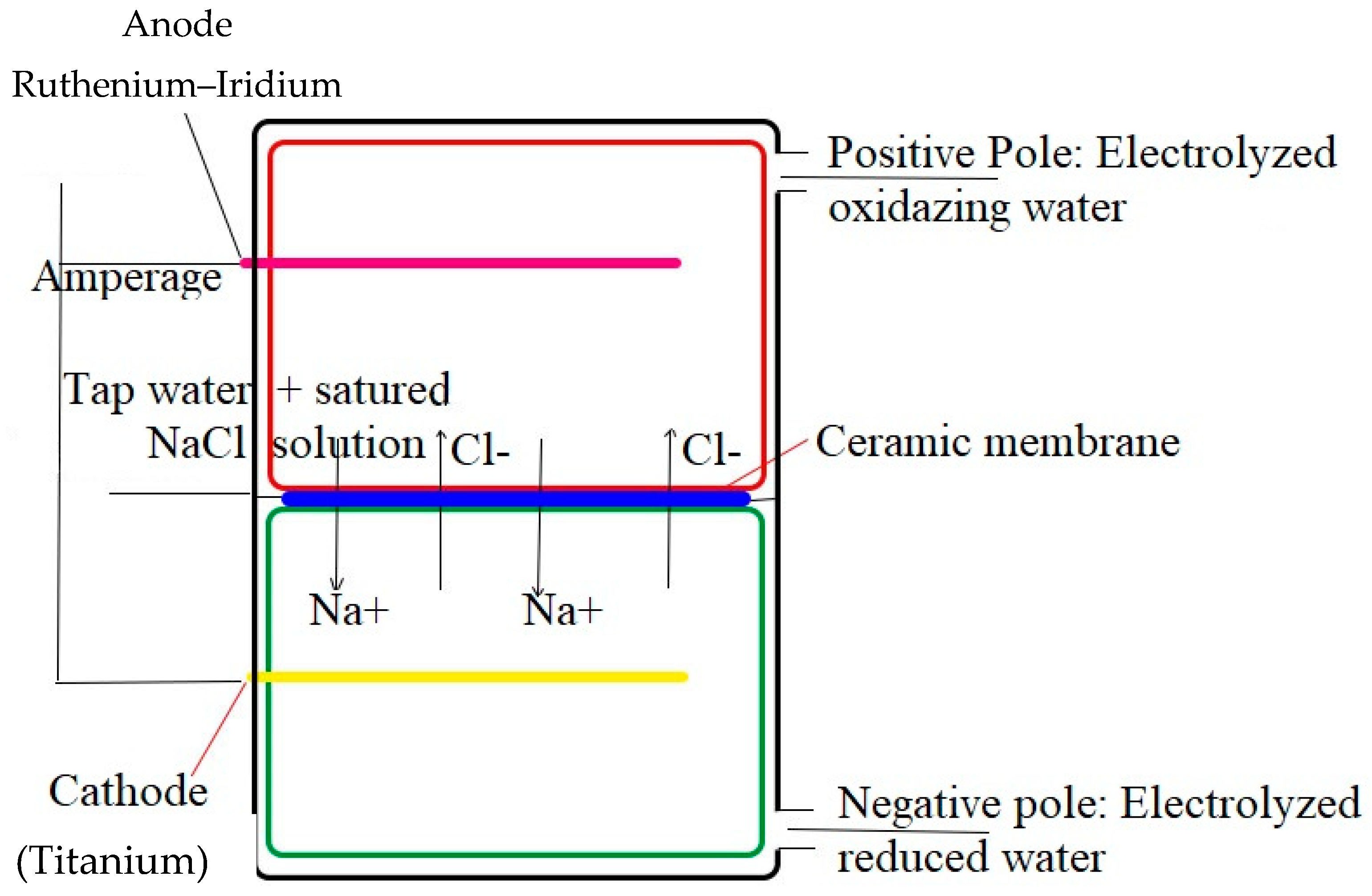
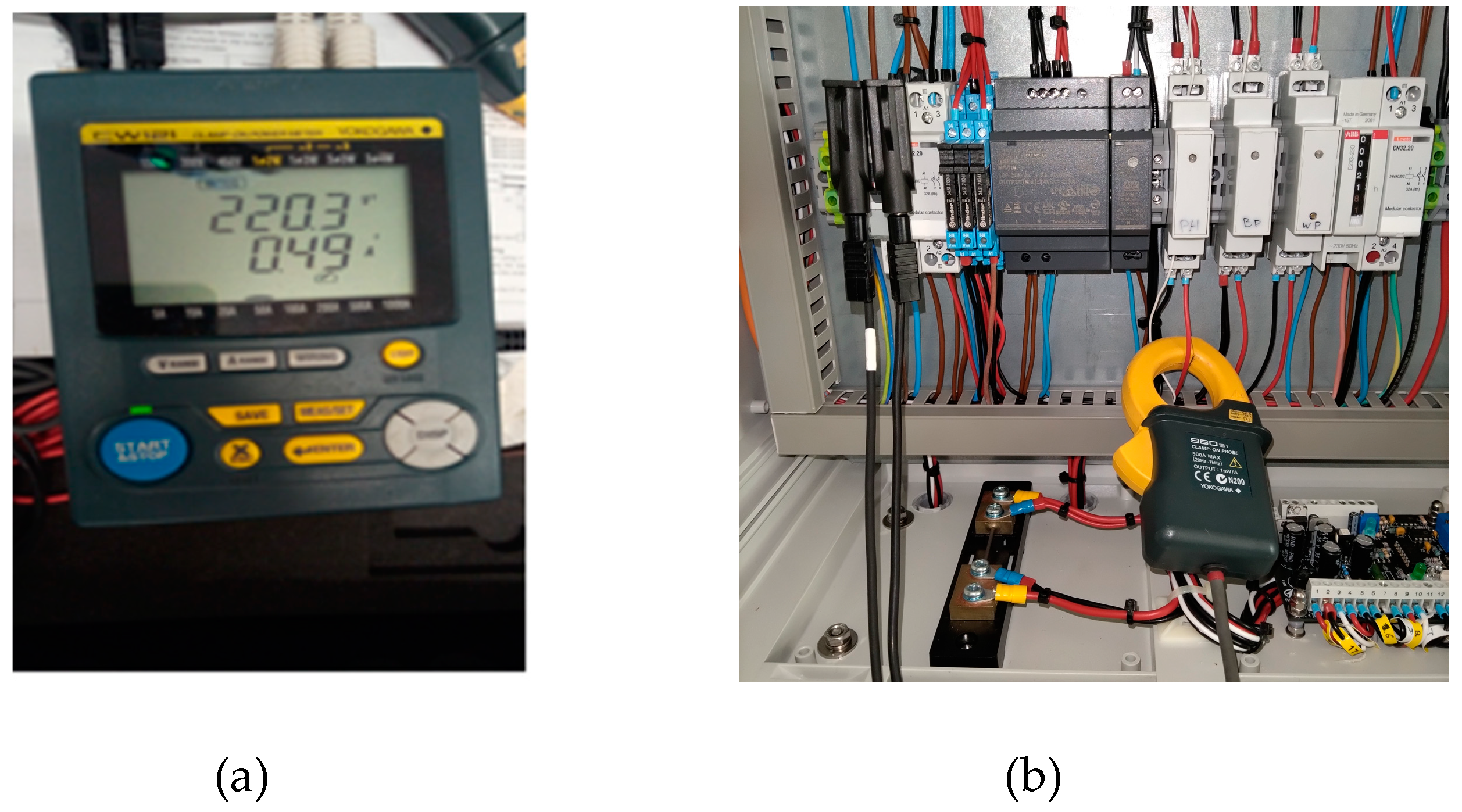
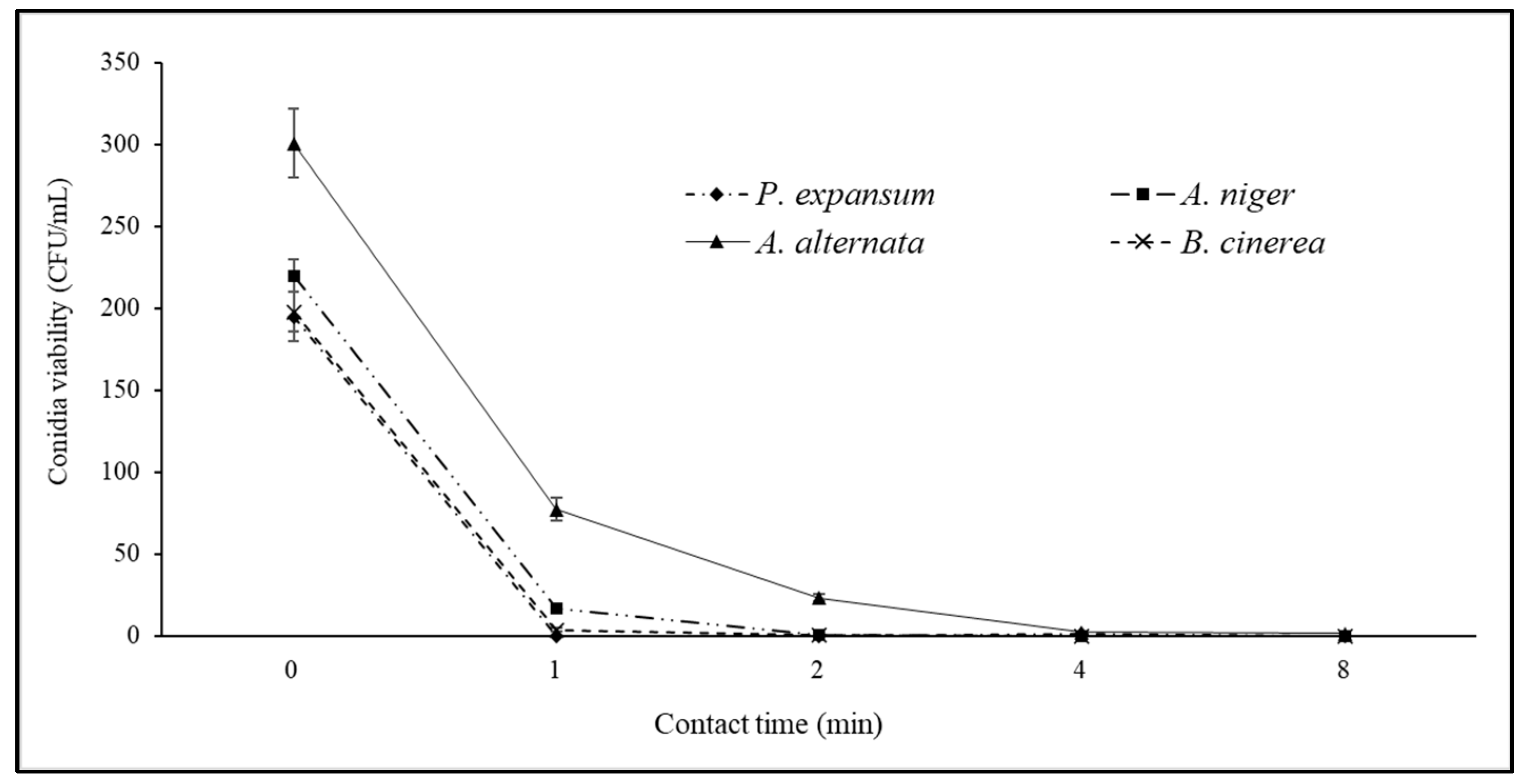


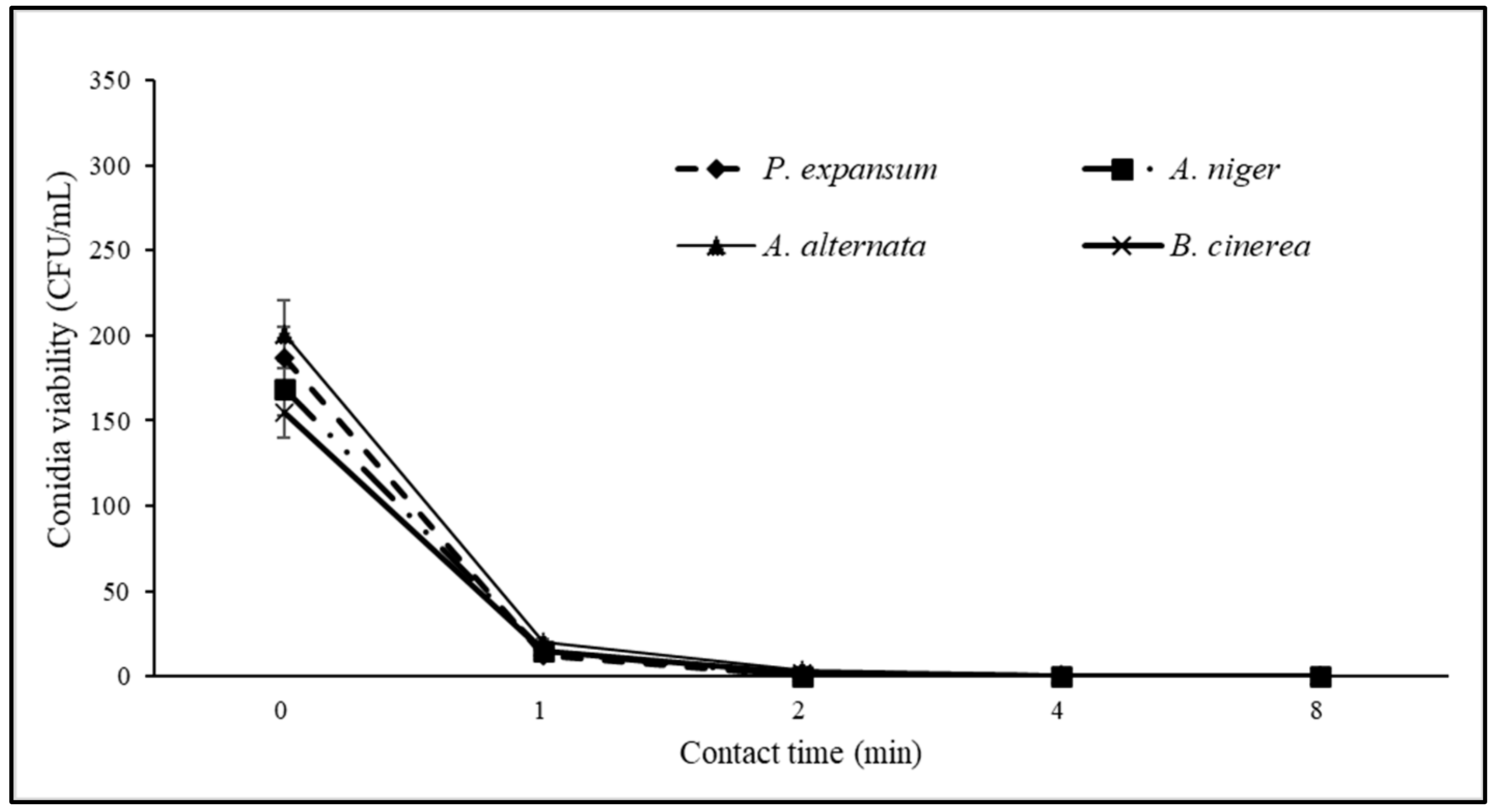

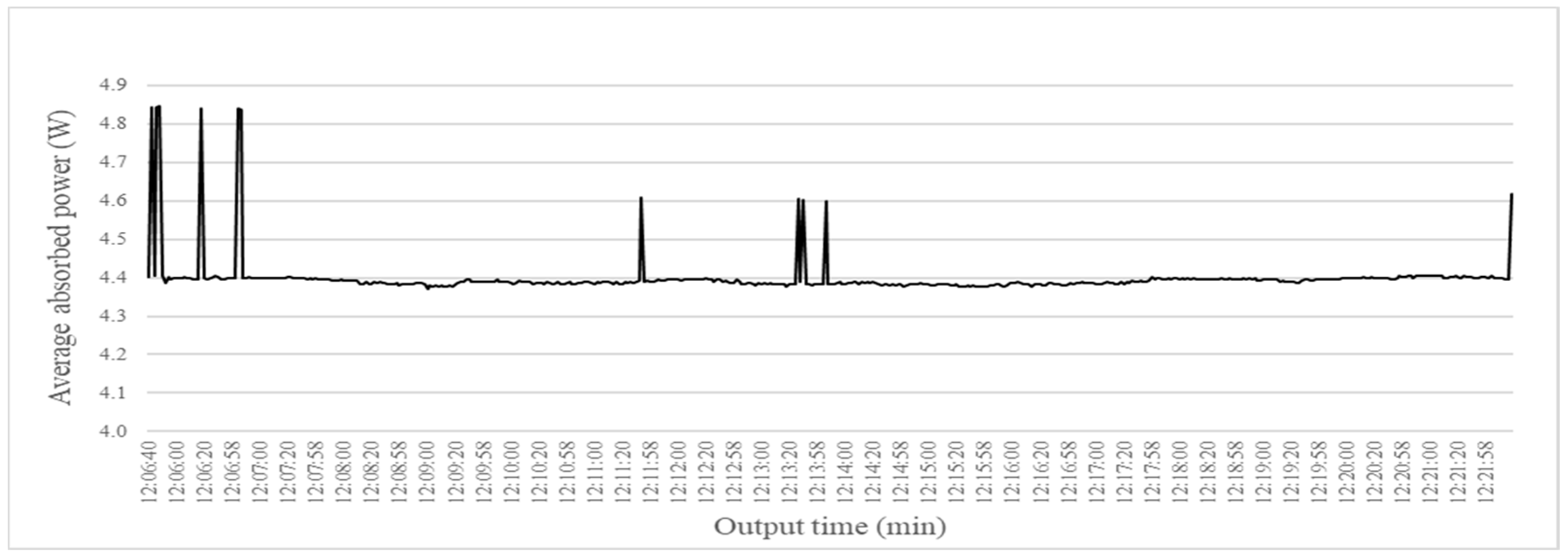
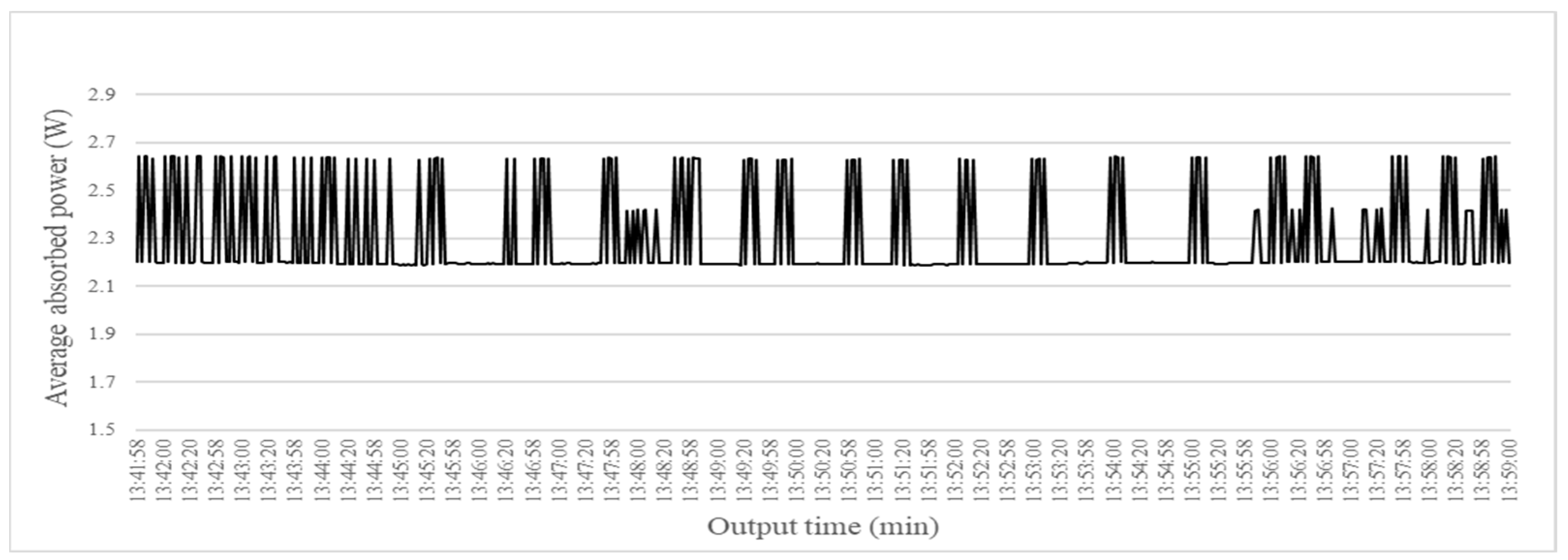
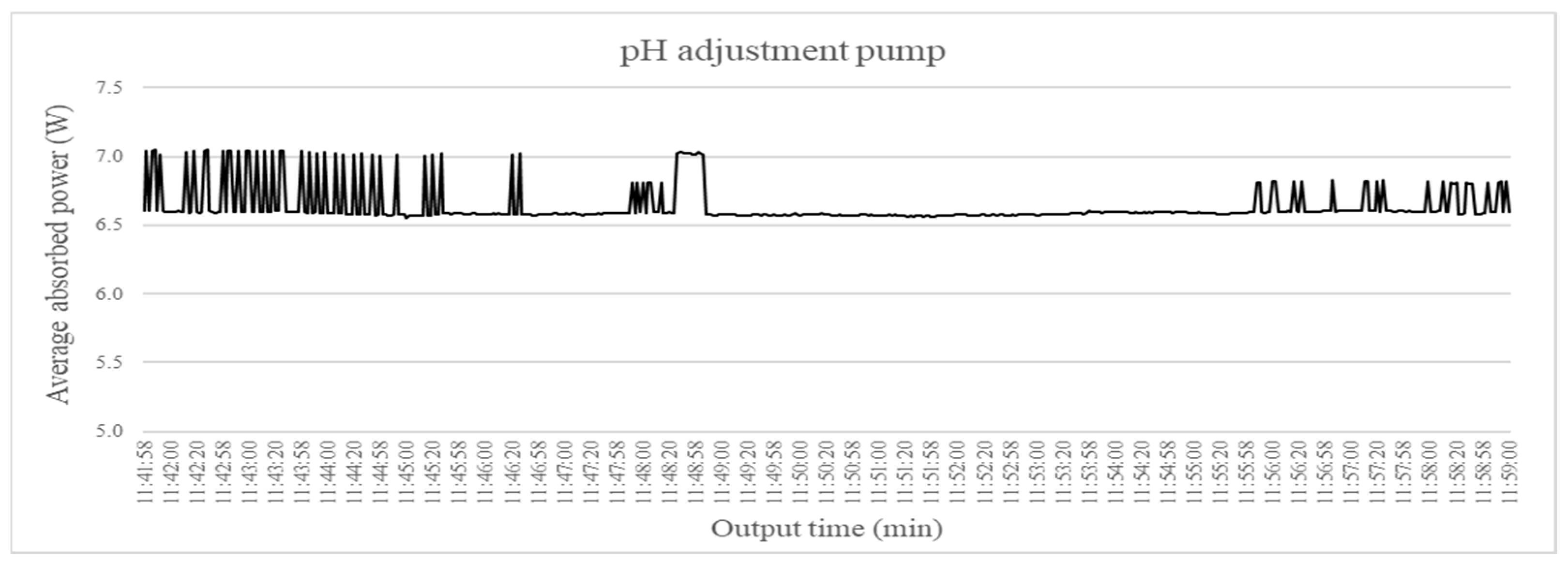
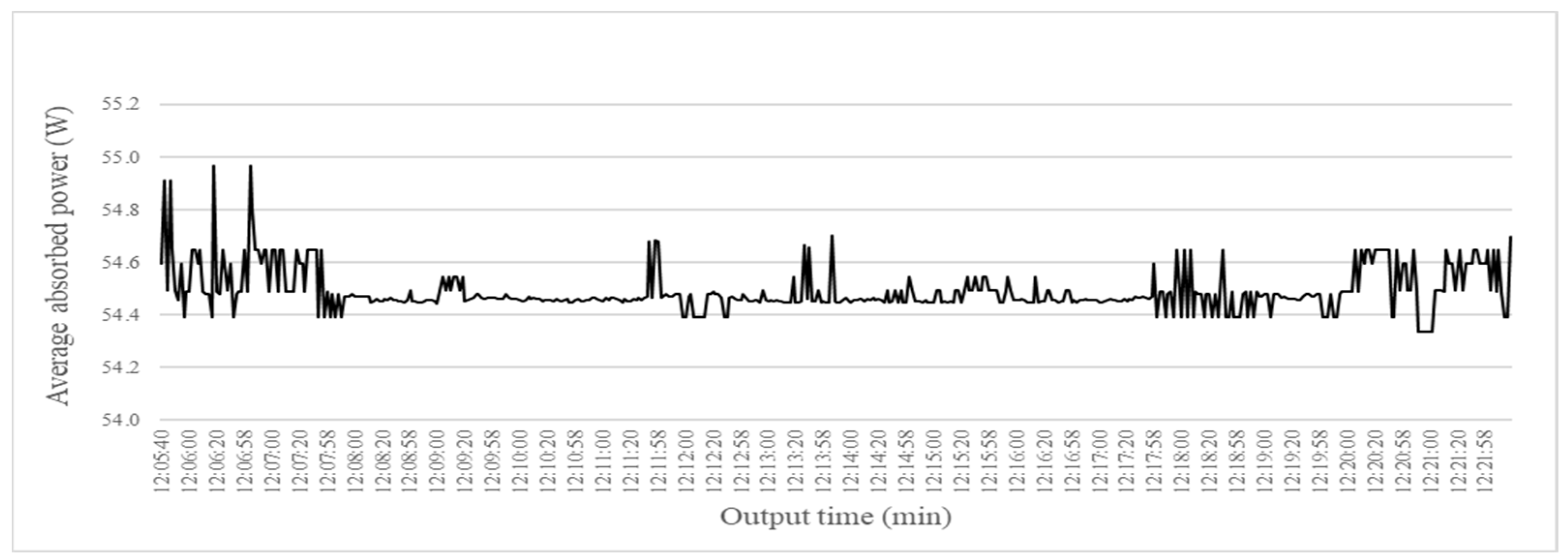
| Type of EW | pH | EOP (mV) | ACC (mg/L) |
|---|---|---|---|
| AEW | 3.8/4.0 | >200 | 20–60 |
| SAEW | 5–5.8 | 200 | 10–30 |
| BWE | 8.7/9.2 | >−100 | 80–100 |
| Parameters | Dilution Rate Electrolyzed Water | |||||||||
|---|---|---|---|---|---|---|---|---|---|---|
| 1% | 2% | 3% | 4% | 5% | 6% | 7% | 8% | 10% | 100% | |
| pH | 5.20 | 5.02 | 5.21 | 4.64 | 4.60 | 4.38 | 4.24 | 4.23 | 4.10 | 3.38 |
| Free chlorine (mg/L) | 1.87 | 1.41 | 1.13 | 2.38 | 1.74 | 2.29 | 2.02 | 1.91 | 2.33 | |
| Total chlorine (mg/L) | 2.20 | 1.69 | 1.32 | 2.48 | 1.95 | 2.31 | 2.07 | 1.95 | 2.34 | |
| Bound chlorine (mg/L) | 0.33 | 0.28 | 0.19 | 0.10 | 0.21 | 0.02 | 0.05 | 0.04 | 0.01 | |
| EOP (mV) | 94.8 | 115.8 | 126.8 | 139.0 | 145.8 | 155.7 | 157.9 | 166.5 | 172.0 | 217.0 |
| Parameters | Dilution Rate Electrolyzed Water | |||||||||
|---|---|---|---|---|---|---|---|---|---|---|
| 1% | 2% | 3% | 4% | 5% | 6% | 7% | 8% | 10% | 100% | |
| pH | 7.50 | 7.72 | 7.70 | 7.65 | 7.70 | 7.80 | 7.80 | 7.90 | 7.90 | 8.20 |
| Free chlorine (mg/L) | 1.10 | 1.46 | 2.13 | 3.14 | 3.81 | 3.86 | 4.90 | 5.70 | 7.40 | |
| Total chlorine (mg/L) | 1.10 | 1.56 | 2.21 | 3.15 | 3.91 | 3.97 | 5.30 | 5.80 | 7.60 | |
| Bound chlorine (mg/L) | 0.00 | 0.10 | 0.08 | 0.01 | 0.10 | 0.11 | 0.40 | 0.10 | 0.20 | |
| EOP (mV) | −43.5 | −42.3 | −41.2 | −42.7 | −41.3 | −41.7 | −51.3 | −47.0 | −49.5 | −60.1 |
| Parameters | Dilution Rate Electrolyzed Water | |||||||||
|---|---|---|---|---|---|---|---|---|---|---|
| 1% | 2% | 3% | 4% | 5% | 6% | 7% | 8% | 10% | 100% | |
| pH | 4.60 | 4.40 | 4.45 | 4.20 | 4.50 | 4.56 | 4.65 | 4.46 | 4.55 | 5.11 |
| Free chlorine (mg/L) | 1.60 | 2.00 | 2.10 | 2.50 | 2.80 | 3.40 | 4.10 | 4.90 | 8.00 | |
| Total chlorine (mg/L) | 1.80 | 2.10 | 2.40 | 2.70 | 3.00 | 3.70 | 4.30 | 5.00 | 8.00 | |
| Bound chlorine (mg/L) | 0.20 | 0.10 | 0.30 | 0.30 | 0.20 | 0.30 | 0.20 | 0.10 | 0.00 | |
| EOP (mV) | 186.0 | 187.0 | 187.0 | 189.0 | 190.0 | 188.0 | 188.0 | 193.0 | 193.9 | 205.0 |
| pH | Flow Rate (L/h) | Brine (L) | Main Water (L) | Anolyte Produced EW (L) | Catholyte as Difference (L) |
|---|---|---|---|---|---|
| 1 | 10 | 0.18 | 9.82 | 6.6 | 3.4 |
| 3 | 10 | 0.18 | 9.82 | 6.6 | 3.4 |
| 5 | 10 | 0.11 | 9.89 | 7.5 | 2.5 |
| 7 | 10 | 0.11 | 9.89 | 7.5 | 2.5 |
| 10 | 10 | 0.10 | 9.90 | 9.9 | 0.1 |
| Machine Components | Electrolyzed Water Generator | Electrolytic Cell | Feed Water Pump | Saturated Solution Feed Pump | pH Adjustment Pump |
|---|---|---|---|---|---|
| Process duration | 60 min | 60 min | 60 min | 60 min | 60 min |
| Active power (avg) | 109.6 W | 54.5 W | 4.4 W | 2.3 W | 6.6 W |
| Active power (std) | 1.08858 | 0.08303 | 0.05607 | 0.17923 | 0.13308 |
| Specific active power | 0.1 kW/L | 0.05 kW/L | 0.004 kW/L | 0.002 kW/L | 0.006 kW/L |
| Energy | 0.01 kWh/L | 0.05 kWh | 0.004 kWh | 0.002 kWh | 0.006 kWh |
| Specific energy | 0.001 kWh/m3EW | 0.005 kWh/m3EW | 0.00004 kWh/m3EW | 0.00002 kWh/m3EW | 0.00006 kWh/m3EW |
| Average Active Power | Work Time | Electrical Energy Absorbed | Specific Electrical Energy | |
|---|---|---|---|---|
| EW Generator 1.0 m3/h | 11.0 kWh/m3 | 1 h | 11.0 kWh | 0.110 kWh/L |
| ECA NaClO2 | 1740 kWh/m3 | 1 h | 1740 kWh | 1.74 kWh/L |
| NaClO2 14% | 244 kWh/m3 | 1 h | 244 kWh | 0.244 kWh/L |
| Energy Cost | Gross Price €/kWh 22.97 | Cost 6% EW Solution | Cost 3% Sodium Hypochlorite | |
|---|---|---|---|---|
| EW generator | 11.0 kWh/m3 EW | 2.51 €/m3 EW | 0.15 € | |
| ECA NaClO2 | 1740 kWh/m3 NaClO2 | 399.70 €/m3 NaClO2 | ||
| NaClO2 14% | 244 kWh/m3 NaClO2 | 56.05 €/m3 NaClO2 | 1.68 € |
Disclaimer/Publisher’s Note: The statements, opinions and data contained in all publications are solely those of the individual author(s) and contributor(s) and not of MDPI and/or the editor(s). MDPI and/or the editor(s) disclaim responsibility for any injury to people or property resulting from any ideas, methods, instructions or products referred to in the content. |
© 2024 by the authors. Licensee MDPI, Basel, Switzerland. This article is an open access article distributed under the terms and conditions of the Creative Commons Attribution (CC BY) license (https://creativecommons.org/licenses/by/4.0/).
Share and Cite
Sanzani, S.M.; Catalano, P.; Tanucci, G.; Giametta, F.; Ippolito, A.; Bianchi, B. Design and Construction and Energy Consumption Study of a New Electrolyzed Water Cell Generator Prototype for Food Disinfection. Sci 2024, 6, 43. https://doi.org/10.3390/sci6030043
Sanzani SM, Catalano P, Tanucci G, Giametta F, Ippolito A, Bianchi B. Design and Construction and Energy Consumption Study of a New Electrolyzed Water Cell Generator Prototype for Food Disinfection. Sci. 2024; 6(3):43. https://doi.org/10.3390/sci6030043
Chicago/Turabian StyleSanzani, Simona Marianna, Pasquale Catalano, Gianluca Tanucci, Ferruccio Giametta, Antonio Ippolito, and Biagio Bianchi. 2024. "Design and Construction and Energy Consumption Study of a New Electrolyzed Water Cell Generator Prototype for Food Disinfection" Sci 6, no. 3: 43. https://doi.org/10.3390/sci6030043
APA StyleSanzani, S. M., Catalano, P., Tanucci, G., Giametta, F., Ippolito, A., & Bianchi, B. (2024). Design and Construction and Energy Consumption Study of a New Electrolyzed Water Cell Generator Prototype for Food Disinfection. Sci, 6(3), 43. https://doi.org/10.3390/sci6030043








